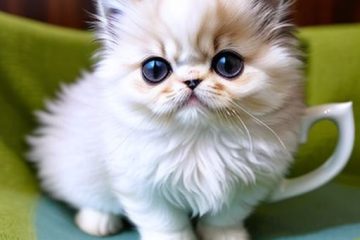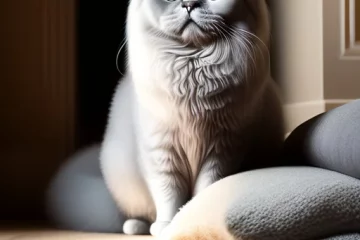The Persian Chinchilla cat, also known as the Silver Persian, is a captivating breed known for its striking appearance and gentle temperament.
With their shimmering silver or golden coats and expressive green or blue eyes, Persian Chinchilla cats have become a popular choice among cat enthusiasts worldwide.
The Persian Chinchilla cat is an exquisite breed that combines the beauty of the Persian cat with the stunning silver or golden coat of the Chinchilla.
With their luxurious and dense fur, they are a delight to touch and behold. Let’s dive into the details of this captivating breed.

Origin and History
The Persian Chinchilla cat breed originated from the crossbreeding of Persian cats and Chinchilla cats.
The Chinchilla breed, known for its silver or golden coat tipped with black, was initially crossed with Persians to create this striking variety.
This breed’s history dates back to the late 19th century, and it has since gained popularity for its unique appearance.
The breeding efforts aimed to capture the elegance and charm of the Persian cat while incorporating the stunning coat color and pattern of the Chinchilla.
Over time, the Persian Chinchilla breeders perfected the desired traits, resulting in the captivating breed we know today.
Physical Appearance
Persian Chinchilla cats are known for their distinct physical features.
They have a medium to large-sized body with a robust build and a round head.
Their eyes are large and expressive, typically green or blue in color.
The most striking feature of the Persian Chinchilla is its dense and lustrous coat, which can be silver or golden with black tipping.
The coat gives them an ethereal and glamorous look.
The body of the Persian Chinchilla is well-proportioned, with a broad chest and sturdy legs.
Their paws are round and firm, complementing their overall balanced appearance.
The head is round and adorned with full cheeks, contributing to their adorable and sweet expression.
The nose is short and slightly upturned, while the ears are small and set wide apart.
Coat and Grooming
The Persian Chinchilla’s coat is its crowning glory. It requires regular grooming to maintain its beauty.
The fur is long, dense, and prone to matting, so daily brushing is essential to prevent tangles and keep the coat in top condition.
The use of a wide-toothed comb or a brush specifically designed for long-haired cats is recommended to gently untangle any knots.
Apart from regular brushing, Persian Chinchilla cats may benefit from occasional bathing to keep their coat clean and free from dirt or oils.
Use a cat-friendly shampoo and follow proper bathing techniques to ensure their comfort and safety.
Pay special attention to drying their coat thoroughly to prevent any dampness that could lead to skin issues.
In addition to coat maintenance, it’s crucial to keep the eyes and ears of Persian Chinchillas clean.
Their eyes may require gentle wiping to remove tear stains or discharge, while the ears should be checked regularly for any signs of infection or excess wax buildup.
Regular dental care, including teeth brushing, can also help maintain their oral health.
Personality and Temperament
Persian Chinchilla cats are known for their gentle and sweet nature.
They are calm, loving, and enjoy a serene environment.
They thrive on human companionship and make excellent indoor pets.
While they may be reserved with strangers initially, they form strong bonds with their owners and love to be pampered.
Persian Chinchillas are generally quiet and prefer a peaceful atmosphere.
Their calm and docile temperament makes Persian Chinchillas well-suited for households with a relaxed lifestyle.
They are content to lounge around and spend quality time with their loved ones.
Despite their calm demeanor, they can still engage in playful activities, especially when provided with interactive toys or engaging games.
Health Considerations
As with any cat breed, Persian Chinchillas are prone to certain health issues. These may include respiratory problems, dental disease, and eye conditions such as entropion or excessive tearing.
Regular veterinary check-ups and proper care are essential to detect and address any health concerns early on.
Responsible breeding practices and genetic testing can help minimize the risk of hereditary conditions.
It’s important to monitor their respiratory health, as Persians are known for their shortened nasal passages, which can lead to breathing difficulties.
Dental care is crucial to prevent periodontal disease and maintain their oral hygiene.
Daily tooth brushing and regular professional dental cleanings are recommended.
The eyes of Persian Chinchillas require particular attention due to their prominent position and potential for issues such as entropion, where the eyelids fold inward, or excessive tearing.
Regular cleaning of the eye area and prompt veterinary care for any signs of discomfort or irritation are necessary.
Feeding and Nutrition
A balanced and nutritious diet is crucial for the overall well-being of Persian Chinchilla cats.
High-quality cat food, preferably formulated for long-haired breeds, should be provided to meet their nutritional needs.
It is important to monitor their weight to prevent obesity, as Persians are prone to weight gain.
Consult your veterinarian for specific dietary recommendations based on your cat’s age, activity level, and health.
Exercise and Playtime
While Persian Chinchillas are not as active as some other cat breeds, regular exercise is important to maintain their health and prevent obesity.
Engage them in interactive play sessions with toys or provide scratching posts and climbing trees to keep them physically and mentally stimulated.
Remember to monitor their activity to avoid overexertion due to their luxurious coats.
Living Environment
Persian Chinchilla cats thrive in a calm and secure indoor environment.
They are sensitive to temperature extremes and prefer a moderate climate.
Ensure their living space is free from hazards and provide comfortable resting areas for their relaxation.
Regular access to fresh water, litter boxes, and scratching posts is essential for their well-being.
Create a safe and enriching environment by offering various toys, scratching surfaces, and cozy hideaways.
Persian Chinchillas enjoy perching on elevated surfaces, so providing cat trees or shelves can fulfill their desire for height and observation points.
Training and Socialization
Persian Chinchillas are generally well-mannered and easygoing.
Early socialization and gentle training can help them adapt to various situations and become more confident.
Introduce them to different people, environments, and experiences gradually to ensure they grow into well-rounded and sociable cats.
Positive reinforcement techniques, such as treats and praise, can be used to reward desired behaviors during training sessions.
However, it’s important to be patient and understanding, as Persian Chinchillas may have a more laid-back approach to learning compared to some other breeds.
You May Also Like: Training Your Persian Cat: Best Tips And Tricks
Conclusion
Persian Chinchilla cats are a stunning breed known for their luxurious silver or golden coats and gentle personalities.
Their striking appearance, combined with their loving and calm nature, make them highly sought after by cat lovers.
With proper care, grooming, and attention to their health needs, Persian Chinchillas can bring joy and beauty to any household.
FAQs
Q1: Are Persian Chinchilla cats hypoallergenic? A: While no cat breed is truly hypoallergenic, Persian Chinchilla cats may produce fewer allergens compared to other breeds. However, individual reactions to cat allergies can vary, so it’s essential to spend time with a Persian Chinchilla before making a commitment.
Q2: How often should I groom my Persian Chinchilla cat? A: Persian Chinchillas require daily grooming to prevent matting and keep their coat in good condition. Regular brushing, occasional bathing, and careful attention to their eyes and hindquarters are necessary for their grooming routine.
Q3: Do Persian Chinchilla cats get along well with children and other pets? A: Persian Chinchilla cats are generally gentle and tolerant, making them suitable companions for children. With proper introductions and gradual socialization, they can also get along well with other pets, including dogs and other cats.
Q4: Are Persian Chinchilla cats high-maintenance in terms of grooming? A: Yes, Persian Chinchilla cats are considered high-maintenance when it comes to grooming due to their long and dense coats. Daily brushing and regular bathing are necessary to keep their fur free from tangles and matting.
Q5: How long do Persian Chinchilla cats typically live? A: With proper care, Persian Chinchilla cats can live on average between 12 to 15 years. Some cats may live even longer with a healthy lifestyle and regular veterinary check-ups.
Q6: Do Persian Chinchilla cats require a specific diet? A: Persian Chinchilla cats benefit from balanced and high-quality cat food formulated for their specific needs. Consult with your veterinarian to determine the best diet plan for your cat’s health and well-being.
Q7: Are Persian Chinchilla cats prone to any specific health issues? A: Persian Chinchillas may be prone to respiratory problems, dental issues, and eye conditions. Regular veterinary check-ups and a proactive approach to their health can help prevent and address these concerns.
Q8: Can Persian Chinchilla cats be left alone for extended periods? A: Persian Chinchilla cats enjoy human companionship and may become lonely if left alone for long periods. They thrive in an environment with regular social interaction and stimulation.
Q9: Are Persian Chinchilla cats indoor cats or can they go outside? A: Persian Chinchillas are best suited for an indoor lifestyle. Their luxurious coats require protection from the elements, and they are at higher risk of injuries or exposure to diseases if allowed to roam freely outdoors.
Q10: How can I keep my Persian Chinchilla cat entertained? A: Provide interactive toys, scratching posts, and comfortable resting areas for your Persian Chinchilla. Engage them in playtime sessions and offer opportunities for mental stimulation to keep them entertained and content.


